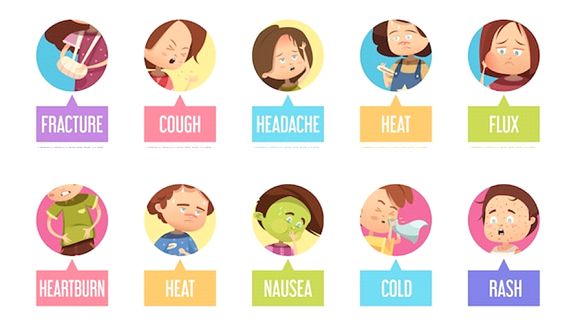Introduction
Typhoid is a bacterial infection that easily spreads through contaminated water and food can lead to a high fever, diarrhoea, and vomiting abdominal pains, headache, and loss of appetite.With treatment, most people make a full recovery. But untreated typhoid can lead to life threatening complications.
Understanding Typhoid Fever
Typhoid Fever is a contagious illness caused by the bacterium Salmonella Typhi. It is primarily transmitted through contaminated food and water, and it spreads rapidly in areas with poor sanitation and hygiene practices. Typhoid Fever can cause high fever, abdominal pain, headache, weakness, and gastrointestinal symptoms, making it a challenging condition to endure.

Causes of Typhoid
Typhoid fever is caused by bacteria called Salmonella typhi.
- Faecal-oral transmission route
- Most people pick up typhoid bacteria while they're travelling. Once they have been infected, they can spread it to others through the faeces and sometimes in the urine of infected people.
- If you eat food that has been handled by someone who has typhoid fever and who hasn't washed carefully after using the toilet, you can become infected.
- People become infected by drinking contaminated water.
- The bacteria may also spread through contaminated food and through direct contact with someone who is infected.
- Typhoid carriers
- The people, known as chronic carriers, no longer have signs or symptoms of the disease themselves. However, they still shed the bacteria in their faeces and are capable of infecting others.
- Typhoid is caused by the bacteria S. typhi. It spreads through food, drinks, and drinking water that are contaminated with infected faecal matter. Washing fruit and vegetables can spread it as well if the water is contaminated.
- Some people have typhoid without experiencing any symptoms. Others continue to harbour the bacteria after their symptoms have gone. Sometimes, the disease can appear again.
- People who test positive for typhoid may not be allowed to work with children or older adults until medical tests are negative.
- It can also be passed through direct contact with a person who has a typhoid infection.
Symptoms of Typhoid
Signs and symptoms are likely to develop slowly — often appearing one to three weeks after exposure to the disease.
- Early symptoms
Signs and symptoms include:
- Symptoms typically begin 1–3 weeks after exposure to the bacteria.
- Fever that starts low and increases daily, possibly reaching as high as 104.9 F
- Rash consists of rose-coloured spots on the neck and abdomen
- (40.5 C)
- Headache
- Weakness and fatigue
- Muscle pain or body ache
- Sweating
- Dry cough
- Loss of appetite and weight loss
- Stomach pain
- Diarrhoea or constipation
- Extremely swollen stomach

- Later symptoms
- Without treatment, you may Become delirious, Lie motionless and exhausted with your eyes half-closed in what's known as the typhoid state
- Life-threatening complications often develop at this time.In some people, signs and symptoms may return up to two weeks after the fever has subsided.
- Other symptoms
- Diarrhoea
- loss of appetite
- bloating
- nausea
- weakness
- high fever
- constipation
- headaches
- stomach pain
- poor appetite
- rash
- fatigue
- Diarrhoea
- Confusion
- Serious complications
- Can include intestinal bleeding or perforations in the intestine.
- This can lead to a life threatening bloodstream infection [sepsis].
- Symptoms include nausea, vomiting, and severe abdominal pain.
Homoeopathy and Typhoid Fever
Homoeopathy offers a holistic approach to managing Typhoid Fever by supporting the body's natural healing mechanisms, reducing symptoms, and promoting overall well-being. Homoeopathic remedies are selected based on an individual's specific symptoms, susceptibility, and overall health. The goal of homoeopathy is to enhance the body's ability to fight infection, prevent complications, and aid in a quicker recovery.
Homoeopathic medicines for typhoid
- Gelsemium sempervirens
- It is indicated at the onset when the patient seems to have taken a cold and the picture starts developing very suddenly.
- It has the typical chill, running down the back, but thirst is absent.
- The pulse is slow, full and soft, and compressible.
- Fever is associated with stupor, dizziness and faintness.
- The patient is prostrated.
- Nux vomica
- Pain in the limbs and back with gastric symptoms
- Patient is chilly and needs to cover in every stage, but the body is burning hot.
- Chill with thirst and heat without thirst.
- Bryonia Alba
- The typhoid is accompanied by constipation, fever with a desire to uncover.
- Has dry burning heat aggravating all other symptoms.
- Chill with external coldness; chill with a hot head and red face;Pulse is full, hard, tense and quick.
- Pulse is full, hard, tense and quick. Easy, profuse perspiration.
- Often there are gastro- hepatic complications.
- Baptisia tinctoria
- Has generalised malaise from severe illness.
- Sore and bruised feeling.Chill all day along, running up and down during the heat stage.
- During apraxia there is a sick, sore feeling all over the body.
- In the third week, gastric complaints arise.
- Typhoid fever with muttering and wandering delirium.
- If given as soon as typhoid is suspected, it cuts the disease short Baptisia falls asleep while answering or does not complete his sentence
- Phosphoricum acidum
- Is indicated during the third week.
- Cerebral symptoms appear. Regardless of surroundings, there is complete apathy.
- The sweat is profuse and exhausting.
- Marked thirst during the sweat stage.
- Muriaticum acidum
- Has great debility, with moaning unconsciousness and cold extremities.
- The patient slides down in bed automatically; there is great prostration.
- Muriaticum Acidum is one of the best medicines for typhoid with involuntary stools and flatus.
- Pyrogenium
- Is suited in conditions of septicemia.
- Severe bone pains in the limb, with chill in the back as soon as the back touches the cold bed sheet.
- The pulse is out of proportion to the temperature, it is abnormally rapid.
- The tongue is red, clean, as if varnished.
- Eucalyptus
- Indicated in rising fever and foul discharges with weak on low pulse.
- Terebinthina
- Typhoid accompanied by stupor, delirium and great prostration
- Arsenic Album
- Arsenic Album is one of the most reliable medicines for typhoid with great prostration and anxiety, especially about health.
- Typhoid with great restlessness and bed sores.
- In such cases, the person keeps changing sides and places continuously due to pain and anxiety.
- Carbo Vegetabilis
- Where a person with typhoid fever feels very exhausted and low.
- Carbo Vegetabilis shows remarkable results in persons who have never fully recovered from the effects of some previous illness.
- Arnica
- Typhoid fever with sore, lame and bruised feelings is treated well with Arnica.
- Persons suffering this condition experience severe limb and body pain similar to someone who was severely beaten up
- Rhus Tox
- Typhoid where it is accompanied by relentless shooting, stitching and tearing pains in the entire body.
- Lachesis
- For Typhoid with Marked Delirium typhoid with delirium where the person experiences delusions and hallucinations, feels full of poison and has great loquacity.
- Typhoid fever with bed sores with dark edges is treated well with Lachesis, which is also one of the top ranked medicines for typhoid fever with violent headache and great loquacity
Benefits of Homoeopathic Treatment
- Individualised Care: Homoeopathy recognizes that each person's experience with Typhoid Fever is unique. A homoeopath will consider your specific symptoms, medical history, and overall health to develop a personalised treatment plan tailored to your needs.
- Supportive Approach: Homoeopathy provides support to the body's immune system, helping it combat the infection and recover naturally. It focuses on strengthening the body's resilience and minimising the risk of recurrent infections.
- Gentle and Natural: Homoeopathic remedies are derived from natural substances and are known for their safety and minimal side effects. They work in harmony with the body, promoting a balanced and holistic healing process.
- Comprehensive Well-being: Homoeopathy considers not only the physical symptoms but also the emotional and mental well-being of an individual. It aims to restore overall health, vitality, and improved quality of life.
Patient Review
Consulting a Homeopath
If you are seeking homoeopathic treatment for Typhoid Fever, it is important to consult with a qualified and experienced homoeopath. At Sanjivani Homeopathy Clinic, our team of skilled homoeopaths will conduct a comprehensive evaluation, considering your symptoms, medical history, and individual characteristics to develop a personalised treatment plan.
Sanjivani Homeopathy Clinic USP
- No homoeopathy Dietary Restrictions:
Allows patients to enjoy foods like onion, garlic, and coffee, ensuring a stress-free treatment journey.
- 24/7 Online Consultations:
Enables convenient access to doctors with detailed counseling, history management, and follow-ups.
- Highly Skilled Team:
Experienced BHMS and MD doctors, supported by multilingual and professional staff.
- Patient-Centric Care:
Simplifies treatment with modern, adaptable solutions and clear communication.
Click Here for Detailed "Sanjivani USP"
FAQ's
- What is homoeopathy ?
Homoeopathy is a holistic science which belives in the law of Similia Similibus Curenter i.e Like Cures Like .It was discovered by Dr Samuel Christian Hahnemannn in 1796.
- Is there any side effects of homoeopathy?
As homoeopathic medicines are made from natural substances this medicines have no side effects and are completely safe to consume
- Is there any diet restriction to take homoeopathic medicines?
There are no diet restrictions for homoeopathic medicines. One should only avoid eating or drinking any liquid other than water at least 30 minutes before and after taking homoeopathic medicines.
Click Here for "Frequently Asked Questions."
Conclusion
Typhoid Fever can be a challenging illness to overcome, but with the holistic approach of homoeopathy, there is hope for natural recovery and enhanced well-being. Sanjivani Homeopathy Clinic is dedicated to providing personalised and effective treatments for Typhoid Fever. Contact us today to embark on a journey towards a healthier and Typhoid-free life.
Disclaimer : The information provided in this blog is for educational purposes only and should not be considered medical advice. Please consult with a qualified healthcare professional before starting any treatment for Typhoid or any other medical condition.


